Experienced General Dentistry in Glendale, AZ
Helping You Achieve Healthy, Happy Smiles!
At Palo Verde Smiles, we want to help you achieve a lifetime of smiles, filled with health and happiness!

Palo Verde Smiles in Glendale, AZ, welcomes children, teens, adults, and seniors from Phoenix, Peoria, and nearby communities. Please contact us to learn more and schedule a visit.
We can’t wait to meet you and start building a friendship while helping you achieve a healthy, happy, beautiful smile.
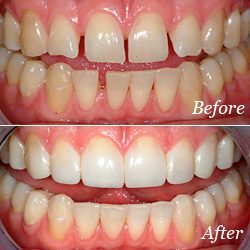
Bonding is a conservative way to repair slightly chipped, discolored, or crooked teeth. During dental bonding, a white filling is placed onto your tooth to improve its appearance. The filling “bonds” with your tooth, and because it comes in a variety of tooth-colored shades, it closely matches the appearance of your natural teeth.
Tooth bonding can also be used for tooth fillings instead of silver amalgam. Many patients prefer bonded fillings because the white color is much less noticeable than silver. Bonded fillings can be used on front or back teeth, depending on the location and extent of tooth decay.
Bonding is less expensive than other cosmetic treatments and can usually be completed in one visit to our office. However, bonding can stain and is easier to break than other cosmetic treatments, such as porcelain veneers. If it does break or chip, tell your doctor. The bonding can generally be easily patched or repaired in one visit.
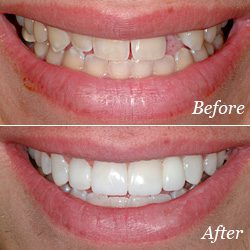
A bridge may be used to replace missing teeth, help maintain the shape of your face, and alleviate stress on your bite.
A bridge replaces missing teeth with artificial teeth, looks great, and literally bridges the gap where one or more teeth may have been. Your bridge can be made from gold, alloys, porcelain, or a combination of these materials and is bonded onto surrounding teeth for support.
The success of any bridge depends on its foundation — the other teeth, gums, or bone to which it is attached. Therefore, it’s very important to keep your existing teeth, gums, and jaw healthy and strong.
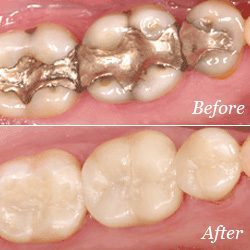
Crowns are a restorative procedure used to improve your tooth’s shape or to strengthen a tooth. Crowns are most often used for teeth that are broken, worn, or have portions destroyed by tooth decay.
A crown is a “cap” cemented onto an existing tooth that usually covers the portion of your tooth above the gum line. In effect, the crown becomes your tooth’s new outer surface. Crowns can be made of porcelain, metal, or both. Porcelain crowns are most often preferred because they mimic the translucency of natural teeth and are very strong.
Crowns or onlays (partial crowns) are needed when there is insufficient tooth strength remaining to hold a filling. Unlike fillings, which apply the restorative material directly into your mouth, a crown is fabricated away from your mouth. Your crown is created in a lab from your unique tooth impression, which allows a dental laboratory technician to examine all aspects of your bite and jaw movements. Your crown is then sculpted just for you so that your bite and jaw movements function normally once the crown is placed.

Regular exams are an important part of maintaining your oral health. During your regular exam, we will:
- Check for any problems that you may not see or feel
- Look for cavities or any other signs of tooth decay
- Inspect your teeth and gums for gingivitis and signs of periodontal disease
- Perform a thorough teeth cleaning
Your regular exam will take about 45 minutes. Each regular exam includes a detailed teeth cleaning, in which we will clean, polish, and rinse your teeth to remove any tartar and plaque that have built up on the tooth’s surface.
Visiting our office every six months gives you a chance to talk to the doctor about any questions you may have about your oral health. Regular exams are offered by appointment only, so please contact our practice today to schedule your next dental exam and teeth cleaning.
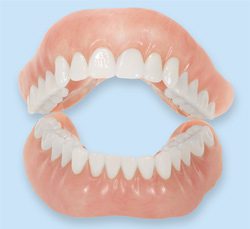
Dentures are natural-looking replacement teeth that are removable. There are two types of dentures: full and partial. Full dentures are given to patients when all of the natural teeth have been removed. Partial dentures are attached to a metal frame that is connected to your natural teeth and are used to fill in where permanent teeth have been removed. Just like natural teeth, dentures need to be properly cared for. Use a gentle cleanser to brush your dentures, always keep them moist when they’re not in use, and be sure to keep your tongue and gums clean as well.
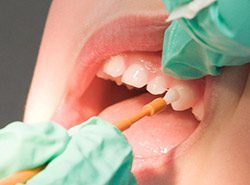
Fluoride is effective in preventing cavities and tooth decay and in preventing plaque from building up and hardening on the tooth’s surface. A fluoride treatment in your dentist’s office takes just a few minutes. After the treatment, patients may be asked not to rinse, eat, or drink for at least 30 minutes in order to allow the teeth to absorb the fluoride. Depending on your oral health or your doctor’s recommendation, you may be required to have a fluoride treatment every three, six, or 12 months.
Many times, we hear from new patients that when they left other dental offices, they had more questions than answers. As a valued patient, every question and concern you have is important and each will be answered to your satisfaction.
Partial crowns, often referred to as only ones, are a type of dental restoration or porcelain filling that covers one or more cusps of your tooth. Onlay’s are also made of porcelain by a lab and take two appointments to complete. An inlay is like a dental filling, but the restoration is made of porcelain by a lab and is placed within the cusps on a tooth’s chewing surface. These restorations are much more conservative than crowns and can be imperceptible from your natural tooth. However, the use of onlays and inlays is limited to very specific situations and is not as common as a dental crown.
What is a Dental Inlay?
An inlay is a lab-fabricated porcelain filling that fits into the grooves of a tooth and does not extend over the cusps of the tooth. The patient is numbed using a local anesthetic and the dentist drills the tooth to remove and clean out the decay in the tooth. This is one of the restorative methods used to repair a tooth after it sustains harm from injury or decay that does not affect the cusps of the tooth. The dentist takes an impression and sends it to a laboratory where the inlay is made.
Inlays are manufactured from porcelain or composite resin material matching the color of the tooth and provide almost invisible dental restoration while repairing the chewing surface. Dental inlays are generally more durable than regular fillings made from composite or amalgam.
What is a Dental Onlay?
Onlays also fit inside the tooth but extend onto the chewing surface of a back tooth to replace one or more cusps. In the past, onlays were made only of gold, but like inlays, more and more patients requested a tooth-colored onlay. Making the onlay of ceramic/porcelain allows the restoration to be bonded to the tooth.
This bonding process may improve the strength of the tooth and help seal the onlay to the tooth. Sometimes It is difficult to determine when inlays or onlays can be used instead of crowns or caps. But, you are in great hands at Palo Verde Smiles as our dentists will review all your options with you to determine the best dental plan.
The word periodontal means “around the tooth”. Periodontal disease attacks the gums and the bone that support the teeth. Your mouth is filled with bacteria. When bacteria are not disrupted on a regular basis, a plaque, or a sticky film of bacteria, debris, and saliva form on the teeth and under the gum line. If plaque is not thoroughly removed each day, it becomes mineralized and turns into calculus (tartar). This build-up on the tooth and root surface becomes rough and harbors the harmful bacteria of the mouth which begins to destroy the gums and bone. Once calculus has formed your toothbrush will not remove the hardened substance and a professional dental cleaning is required to remove the harmful build-up.
Periodontal disease is characterized by red, swollen, and bleeding gums; although not all symptoms need to be present for a diagnosis of periodontal disease.
Four out of five people have some level of periodontal disease and don’t know it! Most people are not aware of the condition because the disease is usually painless in the early stages. If your gums are bleeding, this is not normal and is a sign of disease in your mouth.
Good oral hygiene, a balanced diet, and regular dental visits can help reduce your risk of developing periodontal disease. As well as, genetics and your overall health can play a role in periodontal disease progression.
Signs and symptoms of Periodontal Disease
- Bleeding gums – Gums should never bleed, even when you brush vigorously or use dental floss. Although bleeding gums are common, they are not healthy.
- Loose teeth – Also caused by bone loss or weakened periodontal fibers, which are ligaments that support the tooth to the bone.
- New spacing between teeth – Caused by bone loss.
- Persistent bad breath – Caused by bacteria in the mouth. More than just morning breath.
- Pus around the teeth and gums – This is a sign that there is an infection present.
- Receding gums – Loss of gum around a tooth that can expose the roots of the teeth resulting in sensitivity.
- Red and puffy gums – Gums should never be red or swollen. Medications, medical conditions, and mouth breathing can also cause red and puffy gums. Only a dental professional can properly advise you of the condition of your gums supporting structures around your teeth.
- Tenderness or Discomfort – Plaque, calculus, and bacteria irritate the gums and teeth. They are irritants much like having a sliver in your finger. If you do not remove the sliver the tissue becomes sore and inflamed.
Gingivitis
Gingivitis is the first stage of periodontal disease. Plaque and its toxic by-products irritate the gums, making them tender, inflamed, and likely to bleed. This stage of the disease is reversible with proper professional treatment and compliance at home. This stage affects the gum tissue only, but left untreated it will progress into the surrounding bone.
Periodontitis
Plaque hardens into calculus (tartar). As calculus and plaque continue to build up, the gums and bone begin to recede from the teeth as a result of your own body attempting to fight off the bacterial byproducts associated with gum disease. Deeper pockets form between the gums and teeth and become filled with bacteria, fluid, and sometimes pus. The gums become very irritated, inflamed, and bleed easily. Slight to moderate bone loss is present. This stage is often painless, therefore, it is easy to ignore.
Advanced Periodontitis
The teeth lose more support as the gums, bone, and periodontal ligament continue to be destroyed. Unless treated, the affected teeth will become very loose and will likely be lost. Generalized moderate to severe bone loss may be present. Often this stage of gum disease can still have little pain to alert you of the progression and need for professional treatment.
Treatment
Periodontal treatment methods depend upon the type and severity of the disease. Your dentist and dental hygienist will evaluate for periodontal disease and recommend the appropriate treatment. Be sure your dental exam includes a full periodontal charting that is documented for your review annually.
If the disease is caught in the early stages of gingivitis, and no damage has been done, one to two visits with your dental hygienist for professional cleaning above and below the gum line with medications to reduce bacteria counts are commonly recommended. You will also be given instructions on improving your daily oral hygiene habits and require regular dental cleanings.
If the disease has progressed to more advanced stages, a special periodontal cleaning called scaling and root planing (deep cleaning) will be recommended. This is a non-surgical procedure that can be done in the dentist’s office. One to three appointments will be needed to complete your treatment. Success of your treatment is largely dependent upon your compliance to homecare instructions.
Maintenance
It only takes 24 hours for plaque that is not removed from your teeth to begin emitting the harmful waste product that damages your tissues, teeth, and bones. As well as it can turn into calculus (tartar)! Daily home cleaning helps control plaque and tartar formation, but those hard-to-reach areas will always need special attention. Brushing alone does not properly cleanse all tooth surfaces. Additionally, you must follow the professional maintenance-cleaning schedule your dentist and hygienist recommend for you.
Your personal periodontal evaluation and teeth cleaning appointment will usually include:
- Examination of diagnostic X-rays (radiographs): Essential for early detection of decay, tumors, cysts, and bone loss. X-rays also help determine tooth and root positions.
- Examination of existing restorations and appliances: Check current fillings, crowns, dental implants, dentures, partial dentures, orthodontic retainers, and night guards to prevent tooth grinding damage and bridges.
- Examination of tooth decay: Check all tooth surfaces for decay.
- Oral cancer screening: Check the face, neck, lips, tongue, throat, cheek tissues, and gums for any signs of oral cancer or abnormalities.
- Oral hygiene recommendations: Review and recommend oral hygiene aids as needed. (Electric toothbrushes, special periodontal brushes, fluorides, rinses, etc.)
- Teeth cleaning: Removal of stains and plaque, calculus, above the gum line. Polishing of the tooth surfaces with a fine polishing paste to smooth surfaces.
- Good oral hygiene practices and periodontal cleanings are essential in maintaining dental health and keeping periodontal disease under control.
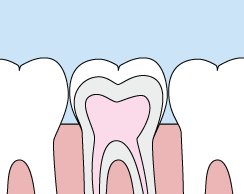
Sometimes brushing is not enough, especially when it comes to those hard-to-reach spots in your mouth. It is difficult for your toothbrush to get in between the small cracks and grooves on your teeth. If left alone, those tiny areas can develop tooth decay. Sealants give your teeth extra protection against decay and help prevent cavities.
Dental sealants are plastic resins that bond and harden in the deep grooves on your tooth’s surface. When a tooth is sealed, the tiny grooves become smooth and are less likely to harbor plaque. With sealants, brushing your teeth becomes easier and more effective against tooth decay.
Sealants are typically applied to children’s teeth as a preventive measure against tooth decay after the permanent teeth have erupted. However, adults can also receive sealants on healthy teeth. It is more common to seal “permanent” teeth rather than “baby” teeth, but every patient has unique needs, and your dentist will recommend sealants on a case-by-case basis.
Sealants last from three to five years, but it is fairly common to see adults with sealants still intact from their childhood. A dental sealant only provides protection when it is fully intact, so if your sealants come off, let your dentist know, and schedule an appointment for your teeth to be re-sealed.
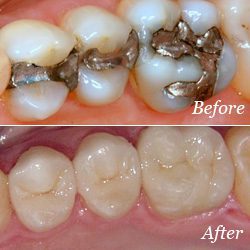
Traditional dental restoratives, or fillings, are most often made of silver amalgam. The strength and durability of this traditional dental material make it useful for situations where restored teeth must withstand extreme forces that result from chewing, often in the back of the mouth.
Newer dental fillings include ceramic and plastic compounds that mimic the appearance of natural teeth. These compounds, often called composite resins, are usually used on the front teeth where a natural appearance is important, but they can also be used on the back teeth depending on the location and extent of the tooth decay.
There are two different kinds of fillings: direct and indirect. Direct fillings are fillings placed into a prepared cavity in a single visit. They include silver amalgam, glass ionomers, resin ionomers, and composite (resin) fillings. Indirect fillings generally require two or more visits. They include inlays, onlays, and veneers. They are used when a tooth has too much damage to support a filling but not enough to necessitate a crown.
